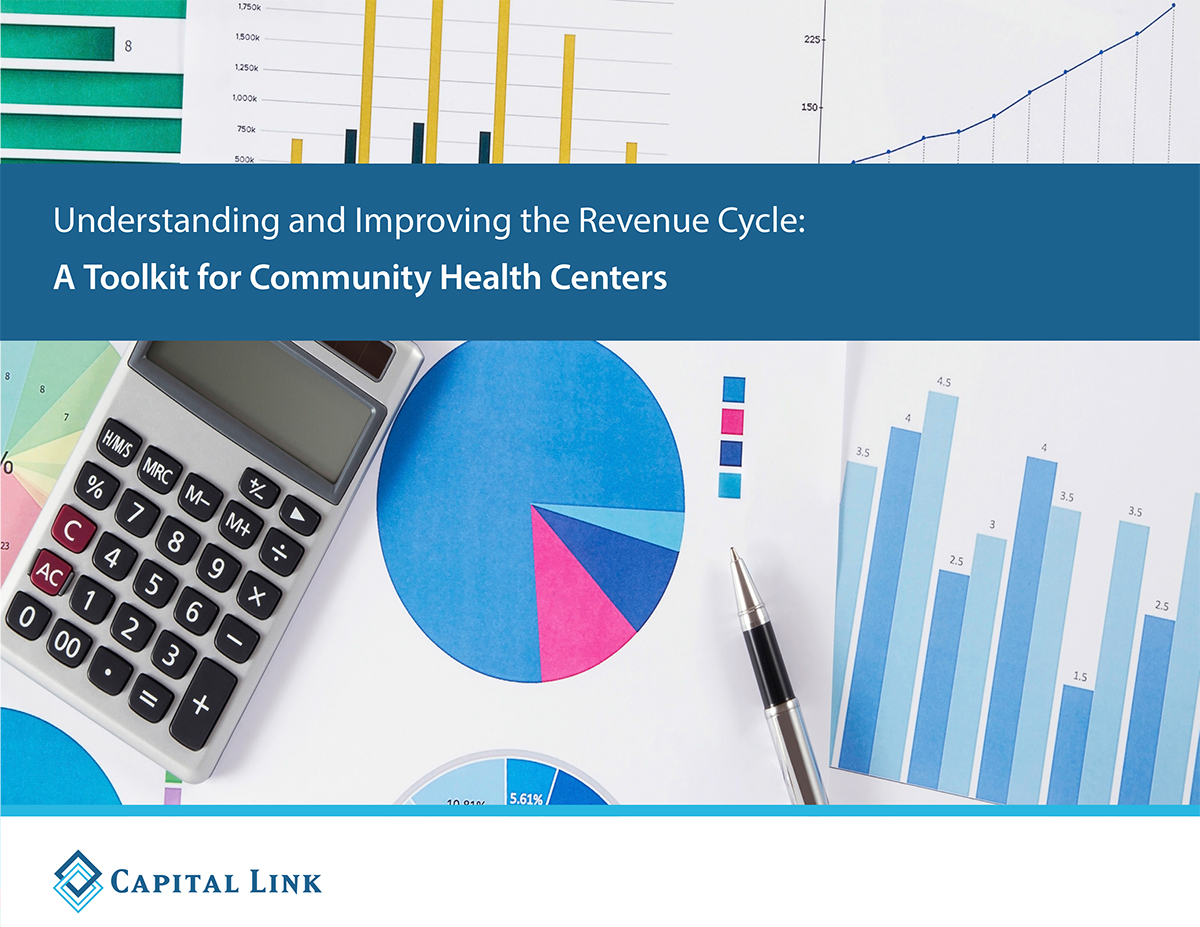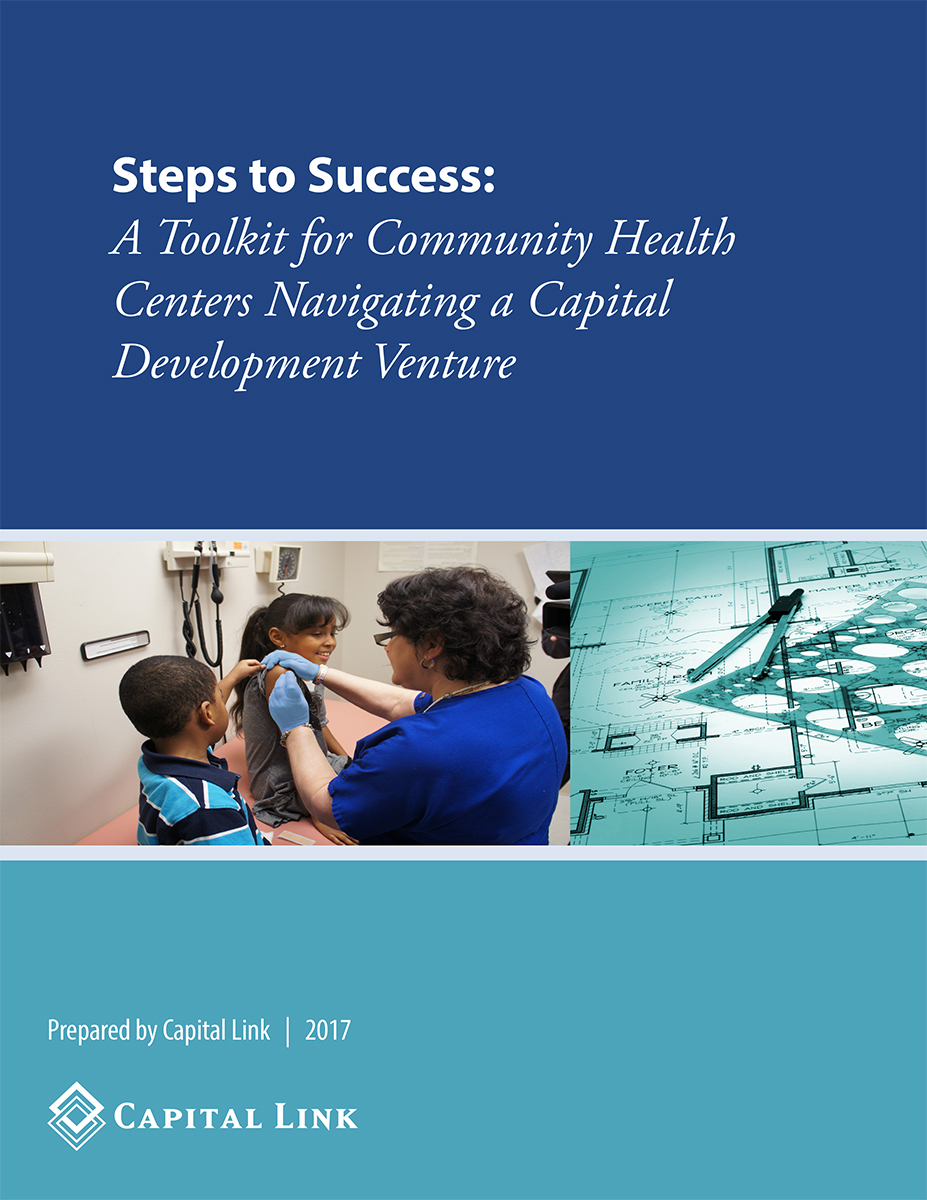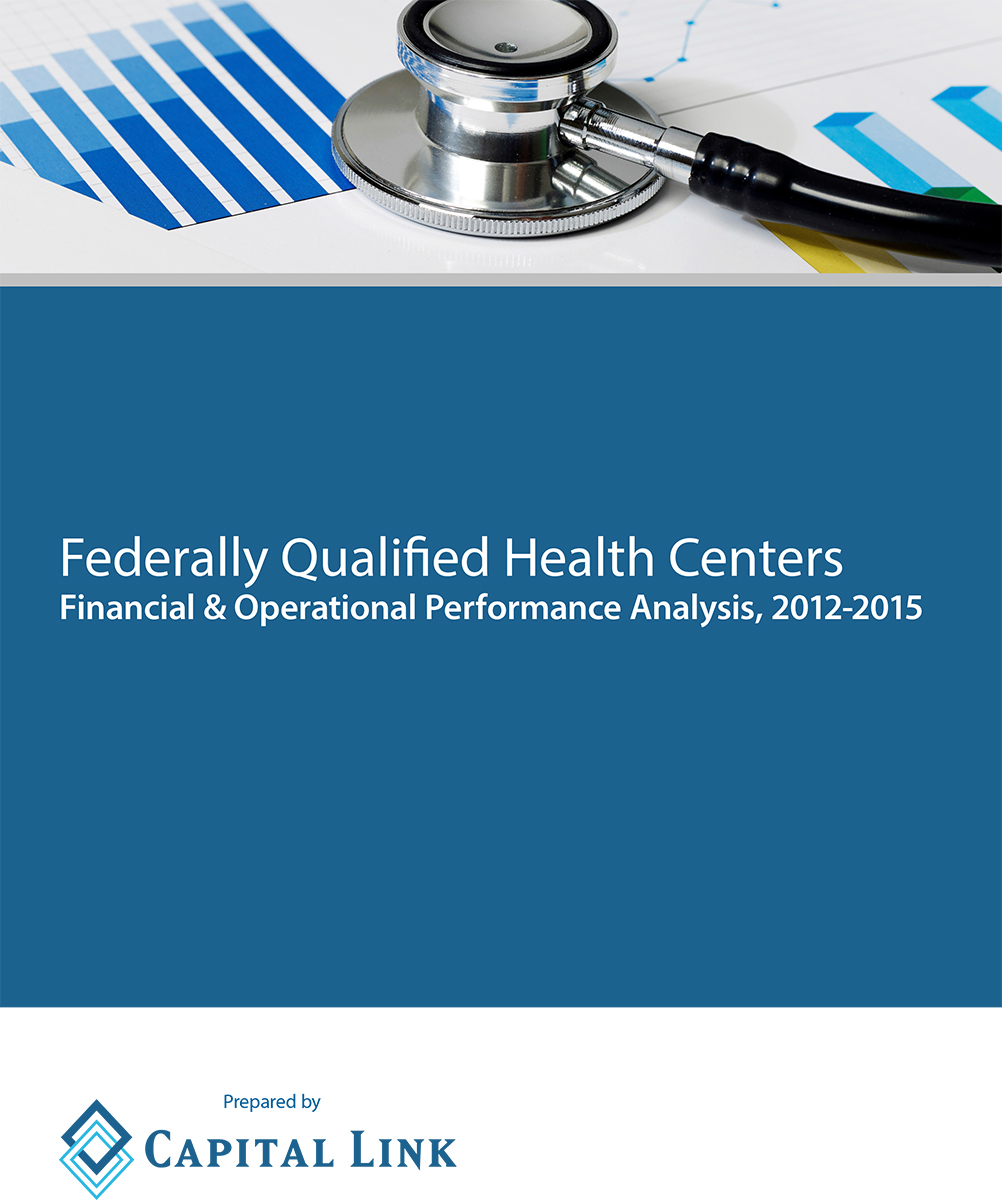![]()

![]()
A Quarterly Resource Bulletin from Capital Link
![]()
Message from the CEO
Every year, summer brings two opportunities for us to celebrate the long and successful history of health centers and highlight the impact they have on the communities they serve: National Health Center Week and NACHC’s annual CHI & EXPO. Capital Link looks forward to participating in both of these important events.
We are tremendously proud to support the health center movement and are happy to announce that Capital Link successfully competed for a three-year National Cooperative Agreement with HRSA. This award allows us to continue to provide a wide-range of capital-related technical assistance to health centers. We plan to release a complete description of activities that will be covered under the agreement in the next issue of Capital Ink.
In this issue of Capital Ink, the article Preparing for Growth: Improvements You Can Make Today puts the spotlight on operational and financial self-assessment—an essential first step in facility expansion planning. A thorough review of your current operational and financial condition helps identify ways to improve efficiencies and inform decisions before developing a plan for growth.
We also preview two new toolkits for health centers that we are planning to release in the next few weeks—Understanding and Improving the Revenue Cycle: A Toolkit for Community Health Centers and Steps to Success: A Toolkit for Community Health Centers Navigating a Capital Development Venture. Later this summer we also expect to release a new national trends report, Federally Qualified Health Centers Financial & Operational Performance Analysis 2012-2015. Be sure to keep an eye out for our emails announcing the release of these valuable resources.
This issue also features an update on the latest federal issues, including a few new grant opportunities, as well as health center highlights and a list of upcoming events. We hope to see you at NACHC’s CHI at our presentations and at our booth in the Exhibit Hall.
Warm Regards,
Allison Coleman, CEO
![]()
Federal Update
Congressional Budget Office Releases Cost Estimates on Impact of AHCA
May 24, 2017 – The Congressional Budget Office (CBO) and the staff of the Joint Committee on Taxation (JCT) completed an estimate of the direct spending and revenue effects of H.R. 1628, the American Health Care Act of 2017 (AHCA), as passed by the House of Representatives. CBO and JCT estimate that enacting the AHCA would reduce federal deficits by $119 billion over the coming decade and increase the number of people who are uninsured by 23 million in 2026 relative to current law. Read more here.
President Releases FY18 Budget Proposal
May 23, 2017 – President Trump released his FY18 budget proposal, which reflects the administration’s priorities for federal spending in the upcoming fiscal year. The President’s budget serves as a blueprint for national priorities and is submitted to Congress as part of the appropriations process. NACHC released a blog post summarizing the potential impact of the budget on health centers, including a two-year fix to the health center funding cliff, extensions of workforce programs and CHIP, and deep cuts to Medicaid. Access NACHC’s post here.
House Passes ACA Repeal-and-Replace Bill
May 4, 2017 – House Republicans passed by a narrow 217-213 vote margin an amended version of the American Health Care Act of 2017 (AHCA), their proposed repeal and replacement of the Affordable Care Act (ACA). Read NACHC’s blog post on the topic here.
Senate Approves FY17 Spending Bill
May 4, 2017 – Senate passes a fiscal year 2017 funding bill that will fund the government through the end of September 2017. The bill covers health care agency and program funding, largely following the outline of measures developed last year. Read more here.
NMTC Program Update: 2017 Application Round Now Open
May 2, 2017 – The US Department of the Treasury's Community Development Financial Institutions Fund (CDFI Fund) announced the opening of the calendar year 2017 New Markets Tax Credit (NMTC) application round. Up to $3.5 billion in tax credit allocation authority are available and the deadline for CDEs to apply is June 21 ,2017. More information is available here on the CDFI Fund website. To find out how Capital Link can help your health center capitalize on this invaluable financing option, please contact Jonathan Chapman, Director of Community Health Center Advisory Services at 970-833-8513 or This email address is being protected from spambots. You need JavaScript enabled to view it..
New HRSA Administrator Announced
May 1, 2017 – The US Department of Health and Human Services announced that George Sigounas, MS, PhD has been appointed as the new HRSA Administrator, effective immediately. Dr. Sigounas was a professor of Internal Medicine at East Carolina University. He completed a post-doctoral fellowship at the National Institutes of Health, and his research interests include stem cells, cancer-initiating cells, and bone marrow transplants. With Dr. Sigounas’ arrival, Jim Macrae returns to his position as Administrator of HRSA’s Bureau of Primary Health Care (BPHC), and Tonya Bowers returns to her position as Deputy BPHC Administrator.
Grant Opportunities for Health Centers
New SAMHSA Grants Available
Building Communities of Recovery grants are available to help build recovery systems for people with substance use disorders. Who may apply: Communities of recovery that are domestic, private nonprofit entities in states, territories or tribes. Deadline: July 3. Learn more here.
Cooperative Agreements to Implement Zero Suicide in Health Systems aims to implement suicide prevention and intervention programs for individuals who are 25 years of age or older. Who may apply: States, the District of Columbia and U.S. Territories health agencies with mental health and/or behavioral health functions; Indian tribe or tribal organizations; community-based primary care or behavioral health care organizations; emergency departments; or local public health agencies. Deadline: July 18. Learn more here.
New HRSA Grant Available
Applications for a new, three-year initiative entitled Improving HIV Health Outcomes through the Coordination of Supportive Employment and Housing Services are being accepted. HRSA will award up to 10 demonstration site grants of up to $300,000 each per year to support the design, implementation, and evaluation of innovative interventions that coordinate HIV care and treatment, housing, and employment services to improve HIV health outcomes for low-income, uninsured, and underinsured people living with HIV in racial and ethnic minority communities. Deadline: July 24. Learn more here.
New and Noteworthy
Preparing for Growth: Improvements You Can Make Today
In developing a long-term facility expansion plan, it is important to for health centers to first engage in a self-assessment. This essential step will help identify immediate action steps to improve operational and financial efficiency, establishing a strong foundation for growth. Below are some suggestions to help health centers pinpoint areas for improvement.
Analyze Your Current Operations
A thorough analysis of current operations before planning a new or expanded facility will help in two ways:
1. To ensure that your new facility has the most efficient layout for effective program delivery;
2. To confirm your facility expansion needs.
Operating effectively and efficiently will result in a strong financial condition, which allows you to weather the impact of a constantly changing political, economic, and funding environment over time.
Areas to focus on:
-
Facility Utilization: What facility characteristics assist or impede service delivery at each of your existing sites? What are the current program, staffing, and operational models for each site and to what extent are they defined by the physical space rather than in response to defined community needs and cultural preferences?
-
Programs and Services:
-
Organization-Wide: Consider how the scope and volume of your services integrates with grant or cooperative agreement opportunities, market/needs assessment findings, and referral barriers. What changes can be made to better serve patients?
-
Site Specific: Does the program of services offered at your sites reflect the needs of their distinct patient populations? Look at the unique characteristics of the immediate community, established re-sources, and facility strengths and see if each site is making the best use of what is available.
-
-
Staffing: For each site, what type and number of staff will be required to support the de¬sired program utilizing the chosen model in the available facility? Develop a list of current staff by site, department, and service and see if it matches your operating model. If not, what training is required for current staff to work more effectively? What recruitment strategies would better support your operating model?
-
Operational Metrics: As you look to evaluate your health center operations, it is helpful to track various metrics over time so that positive trends as well as warning signs are recognized in a timely manner. Of course, each health center will have its own approach to measuring progress along chosen indicators, but whichever metrics are used, it is important that the data is tracked consistently and comprehensively. Examples of operational tracking measures may include the following:
-
Growth: Total Visits; Total Patients, Total FTEs, Providers/FTEs
-
Productivity: Visits per Provider, Patients per Provider, Patients per Provider Panel (or Providers + Clinical Support Staff), Visits per Provider FTE
-
Utilization & Revenues/Costs: Visits per Payer; Patients per Payer, Net Revenue per Visit, Net Revenue per Visit per Payer; Cost per Visit; Cost per Patient, Visits per Exam Room (per day and year)
-
The benefit of trending operational metrics over time is that it provides a health center with its own baseline from which to measure progress. For certain measures, there may also be standardized benchmarks to compare against, especially if provided by HRSA. Although data results on their own may not tell the whole story, they do point to operational areas that may need further attention or at least point to alternative metrics that may better represent the model of care for a specific health center.
Analyze Your Financial Strength
Strong financial measures are the result of strong operations. A fiscally sound health center has strong operating margins and a solid balance sheet, achieved through good provider productivity, properly coding patient visits, and a strong outreach and enrollment program to match patients with the best programs for which they are eligible. Tracking these measures is vital to informed decision-making and planning, both for short-term success and future growth.
Areas to focus on:
-
Profitability: The Operating Margin and Bottom Line Margin are key indicators of health centers’ ability to generate income needed to sustain current operations and to support both short-term and long-term growth.
-
Growth: Year-to-year growth rates for Operating Revenue, Net Patient Service Revenue and Grant and Contract Revenue, as well as for Operating Expense.
-
Solvency: Current Ratio, Days Unrestricted Cash on Hand, Days in All Accounts Receivable, Days in Patient Accounts Receivable, Days in Accounts Payable reflect the health centers’ ability to maintain a positive cash flow and to meet immediate obligations.
-
Debt Capacity: The Leverage Ratio and the Debt Service Coverage Ratio examine the ability to meet long-term obligations to creditors and other third parties.
Capital Link has several resources to assist you in assessing your operational and financial condition in preparation for growth:
-
Coming Soon – Steps to Success: A Toolkit for Community Health Centers Navigating a Capital Development Venture
-
Coming Soon – Federally Qualified Health Centers Financial & Operational Performance Analysis 2012-2015
-
Preparing for a Capital Project: Are You Ready? (publication: http://www.caplink.org/resources/publications)
-
Performance Benchmarking Toolkit for Health Centers (toolkit: http://www.caplink.org/resources/publications)
-
Hallmarks of High Performance: Exploring the Relationship between Clinical, Financial and Operational Excellence at America’s Health Centers (publication: http://www.caplink.org/resources/publications)
-
High-Performance Community Health Centers: Learning, Measuring, and Achieving (publication: http://www.caplink.org/resources/publications)
-
High-Performance Community Healthcare: How to Measure It and How to Achieve It (webinar: http://www.caplink.org/events/webinars)
![]()
Resources
Coming Soon! Understanding and Improving the Revenue Cycle: A Toolkit for Community Health Centers
In order to remain financially viable, health centers must quickly and accurately capture all available patient service revenue. Ensuring efficient and effective processes across the many functions of the revenue cycle is critical to a health center’s financial sustainability. Capital Link will soon be releasing a new toolkit for health centers that provides an overview of the revenue cycle management process and best practices for each function. It also includes suggested key performance indicators and helpful resources. Keep an eye out for our email announcing the release of this resource in the next few weeks.
Coming Soon! Steps to Success: A Toolkit for Community Health Centers Navigating a Capital Development Venture
Health centers hoping to undertake a capital development project quickly discover that is a complex endeavor. Projects are much more manageable when health centers follow a methodical process with an emphasis on clear project goals and an organized plan to achieve them. Capital Link’s new toolkit will provide health centers with the fundamental building blocks to create a foundation for successful project completion. We will be announcing the release of this toolkit shortly.
Coming Soon! Federally Qualified Health Centers Financial & Operational Performance Analysis 2012-2015
This report provides an aggregate financial and operational profile of community health centers. By presenting multi-year results from health centers nationally, this report offers a framework for identifying the financial strengths, challenges, and benchmarks that support opportunities for performance improvement. We will be releasing this report later this summer.
National Health Center Week Resources
This year’s National Health Center Week (NHCW) is August 13-19, 2017 with the theme of “Celebrating America’s Health Centers: The Key to Healthier Communities.” To help health centers spread the word about the celebration, the Health Center Advocacy Network has a variety of tools and resources on the brand new NHCW website. Access them here.
![]()
Health Center Highlights
Capital Link regularly profiles health centers that have successfully completed their expansion plans. These health center stories are available on our website. Read the latest additions to our series of health center project success stories — Family Health Center, MI and Mountain Park Health Center, AZ, which were both financed with support from Healthy Futures Fund 2.0. In the next few weeks, we will be releasing a project highlight featuring ChapCare, CA and an impact analysis on Family Health Centers of San Diego, CA.
We want to congratulate Community of Hope, Inc. in Washinton DC, for recently closing financing on a $8.24 million lease and renovation of a new facility. Upon completion in the summer of 2018, Community of Hope’s new 8,800 square-foot health center facility will be part of The Commons at Stanton Square, a large multi-purpose development located in the Fort Stanton/Hillsdale area of DC’s Ward 8. The Commons will serve as a campus for community programs co-located with mixed- and low-income housing. Capital Link lending affiliate, Community Health Center Capital Fund, in collaboration with Local Initiatives Support Corporation (LISC), Morgan Stanley, and The Kresge Foundation, provided funding for the project through Healthy Futures Fund 2.0. Read more here.
![]()
Upcoming Conferences & Trainings
Capital Link regularly attends industry conferences to exhibit, conduct trainings, and present information related to capital development to health centers and primary care associations. Below are a few of our next scheduled events. Learn more here.
Presentations
Health Center Association of Nebraska Conference
June 8, 2017
Nebraska City, NE
Interpreting Performance Evaluation Profiles (PEPs) and Identifying Next Steps for Financial Advancement
Presenter: Jonathan Chapman, Director of CHC Advisory Services, Capital Link
National Health Care for the Homeless Conference & Policy Symposium
June 21-24, 2017
Washington, DC
Health and Supportive Housing Capital Expansion: Building Access, Impact and Equity for Vulnerable Populations in our Communities
Presenters: Jane Bilger, Senior Program Manager, CSH; Jonathan Chapman, Director of CHC Advisory Services, Capital Link; Kelly McShane, President and CEO, Community of Hope DC
Association of Clinicians for the Underserved (ACU) Annual Conference
July 30-August 2, 2017
Washington, DC
Creating Effective Spaces for Primary Care Teams
Presenter: Cindy Barr, RN, Operations & Facilities Planner, Capital Link
NACHC 2017 Community Health Institute & EXPO
August 25-29, 2017
San Diego, CA
Creating a Dynamic and Useful Strategic Plan (Pre-Conference Training)
Saturday, August 26
Presenters: Cindy Barr, RN, Operations & Facilities Planner, Capital Link; Jonathan Chapman, Director of CHC Advisory Services, Capital Link; Terry Glasscock, Senior Project Consultant, Capital Link
Integrated Models to Support an Aging Population
Date/Time TBD
Presenters: Allison Coleman, MBA, CEO, Capital Link; Candace Baldwin, Director of Strategic Aging Initiatives, Capital Impact Partners; Patsy Jensen, Executive Director, Shawnee Health Service; Marty Lynch, CEO Lifelong Medical Care
Arkansas Primary Care Association Annual Conference
September 20-22, 2017
Little Rock, AR
High Performers and the Transition to Value-Based Payments (Training for Board Members)
Presenter: Jonathan Chapman, Director of CHC Advisory Services, Capital Link
Webinars
Financing Your Capital Projects with a Lender's Perspective
Wednesday, June 21, 2017, 2:00-3:00 PM ET
Presenters: Terry Glasscock, Senior Project Consultant, Capital Link; Jonathan Chapman, Director of CHC Advisory Services, Capital Link; and Ian Wiesner, Manager, Business Development, Capital Impact Partners
Learn more here.
Access recordings of past webinars here.
![]()




